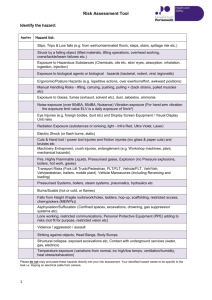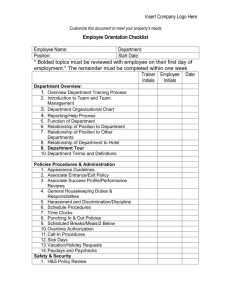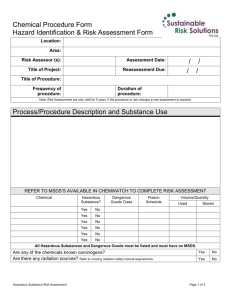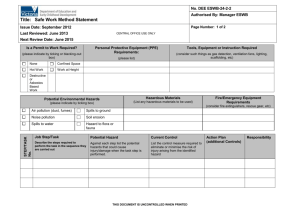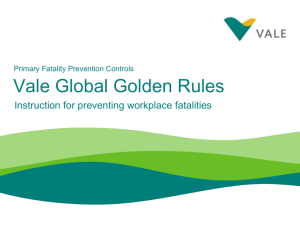New Employee Safety Orientation Checklist
advertisement
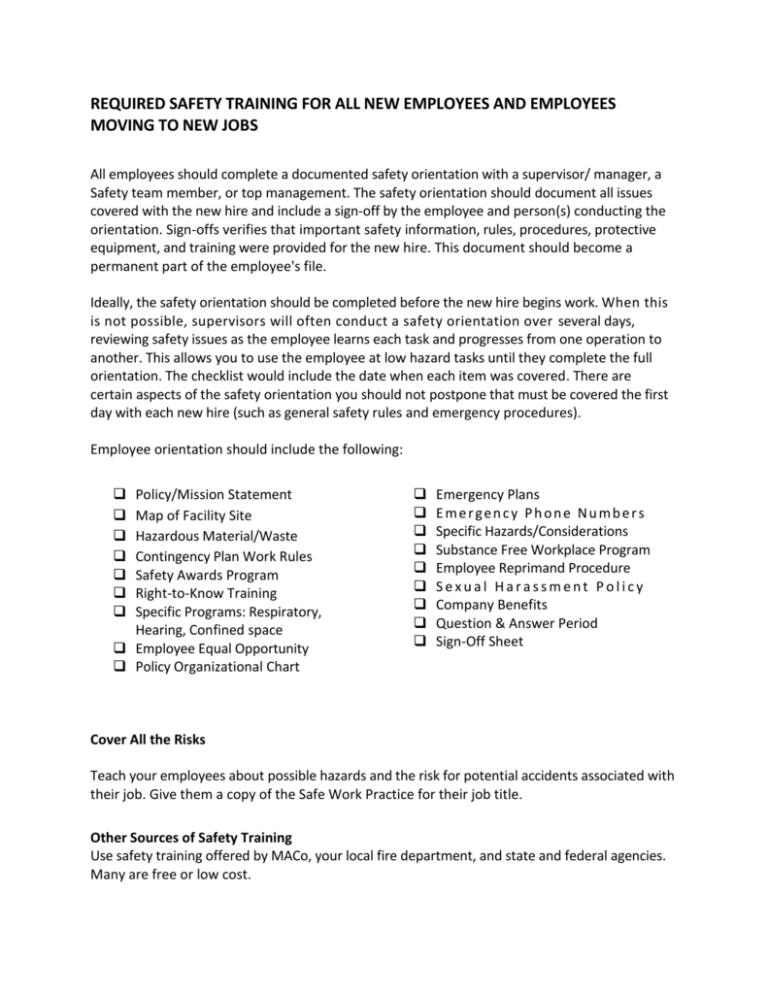
REQUIRED SAFETY TRAINING FOR ALL NEW EMPLOYEES AND EMPLOYEES MOVING TO NEW JOBS All employees should complete a documented safety orientation with a supervisor/ manager, a Safety team member, or top management. The safety orientation should document all issues covered with the new hire and include a sign-off by the employee and person(s) conducting the orientation. Sign-offs verifies that important safety information, rules, procedures, protective equipment, and training were provided for the new hire. This document should become a permanent part of the employee's file. Ideally, the safety orientation should be completed before the new hire begins work. When this is not possible, supervisors will often conduct a safety orientation over several days, reviewing safety issues as the employee learns each task and progresses from one operation to another. This allows you to use the employee at low hazard tasks until they complete the full orientation. The checklist would include the date when each item was covered. There are certain aspects of the safety orientation you should not postpone that must be covered the first day with each new hire (such as general safety rules and emergency procedures). Employee orientation should include the following: Policy/Mission Statement Map of Facility Site Hazardous Material/Waste Contingency Plan Work Rules Safety Awards Program Right-to-Know Training Specific Programs: Respiratory, Hearing, Confined space Employee Equal Opportunity Policy Organizational Chart Emergency Plans Emergency Phone Numbers Specific Hazards/Considerations Substance Free Workplace Program Employee Reprimand Procedure Sexual Harassment Policy Company Benefits Question & Answer Period Sign-Off Sheet Cover All the Risks Teach your employees about possible hazards and the risk for potential accidents associated with their job. Give them a copy of the Safe Work Practice for their job title. Other Sources of Safety Training Use safety training offered by MACo, your local fire department, and state and federal agencies. Many are free or low cost. EMPLOYEE SAFETY ORIENTATION CHECKLIST Employee's Name: __________________________________________ Hire Date: _____________ Position: _________________________________________________________________________ Department/Location: _____________________________________________________________ _ Person Completing Orientation: _______________________________ Title: _________________ Employee Safety Rules Provide copy of General Safety Rules. Provide copy of Safety Discipline Procedures. Provide copy of Area Safety rules (If applicable). Unsafe Conditions Discussed examples of unsafe conditions. Discussed correction and/or reporting of unsafe conditions. Lifting Techniques Discussed common lifting/strain injury hazards. Discussed material handling equipment available/used. Reviewed correct lifting techniques and guidelines. Accidents and Incidents Discussed common lifting/strain injury hazard. Discussed material handling equipment available/used. Reviewed correct lifting techniques and guidelines. Medical Aid Identified readily available first aid personnel. Reviewed location of emergency first aide materials. Discussed notifying supervisors of first aid injuries. Identified location of emergency eye-wash station. Emergency Procedures Identified location use of emergency telephone numbers. Reviewed procedures for fire/medical emergencies. Discussed procedures for extreme weather and other emergencies. Personal Protective Equipment Requirements (if applicable) Footwear Eye Protection Gloves Other Department and Area Housekeeping Discussed common problems/corrective measures. Discussed materials storage areas and practices. Fire Protection and Prevention Identified and discussed "No Smoking" areas. Discussed location and use of fire extinguishers and fire alarms. Hazard Communication/Rights to Know Compliance Discussed requirements of the law. Discussed container labeling and MSDS information. Identified hazardous materials used in the work area. Conducted hazardous material training. Issued personal protective equipment. Driver Safety Orientation (if applicable) Completed personal driving record (MVR) check. Provided/reviewed driver safety rules. Conducted driver's vehicle orientation. Reviewed vehicle inspection procedures. Provided driver with accident information package. Other Safety Concerns/Instruction ______________________________________________________________ ______________________________________________________________ ______________________________________________________________ ______________________________________________________________ TRAINING TOPICS Bloodborne Pathogens Confined Space (If Applicable) Ergonomics Fall Protection Fire Prevention/Emergency Action Plan Flammable Materials Forklift Operations (Training and Certification) Hazard Communication Hazardous Waste Hearing Conservation Lock-Out/Tag-Out Montana Safety Culture Act People Base Safety (Highly Recommended) PPE Respiratory Protection (If Applicable) TB Trenching (If Applicable) Vehicle Prevention Maintenance & Pre-Drive Checks Work Place Violence TRAINING COMMENTS KEEP RECORDS The counties are required to maintain the following safety records covering the last five years' safety-related activities: Site-specific safety requirements file, for example, maintenance of machinery, equipment, and vehicle; Minutes of Safety Committee Meetings; Safety training activities and certificates; Safety audit reports; OSHA 300 log, OSHA 300 annual summaries; Safety incident reports; Injury reports; and Safety citations.

